Kathmandu
The country’s cultural capital, Kathmandu is the place where most adventures in Nepal begin, as all flights from overseas land in the city’s Tribhuvan International Airport. A crowded metropolis of more than 2 million inhabitants, Kathmandu is a chaotic mix of tourist shops, trekking agencies, hotels, restaurants, religious sites and artisan workshops.
One of the best things about Kathmandu has to be the eclectic mix of temples, historic sites, shrines, restaurants and bustling streets.
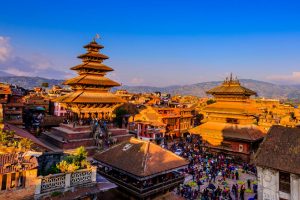
-
Reviews 3 Reviews5/5
-
Vacation Style Holiday Type
-
Culture
-
-
Activity Level Fairly Easy
-
Filling the Kathmandu Valley in which it lies, the ‘City of Temples’ is home to lots of astounding historical and cultural sights for you to explore. As such, you’ll find marvelous palaces and age-old temples lying alongside bustling bazaars, selling every kind of product imaginable. As well as being the commercial, cultural, and political center of the country, it is also its spiritual and religious heart.
You can also plan a hiking or trekking trip, shop your heart out at the Thamel area and eat delicious local grub at restaurants like Forest and Plate, Places, and Yangling.
Don’t forget to buy some gorgeous handicrafts while you’re here, too.
Places to Visit in Kathmandu
1. Akash Bhairav Temple Kathmandu
Akash Bhairav (NepalBhasa) is one of the different forms of Bhairava. He is known as King Yalambar in History of Nepal, as Barbarika in Mahabharata. The temple of Akash Bhairav is supposed to have been a palace of the first king of Nepal, Kiranti King Yalambar around 3100–3500 years back. The head of the Aakash Bhairav was dug up several hundred years ago in Kathmandu. It is taken out once a year on the occasion of Yenya Festival and blessed by the Kumari, the living goddess. This ceremony is held in the month of August/September. During the ceremony, large number of worshippers come to visit this temple. They offer Peda, flowers, money and several others things. Followers from all over the world come to Kathmandu to be a part of the important pooja rituals performed during this time of the year.
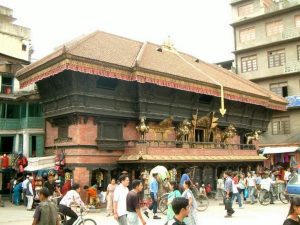
2. Annapurna Temple Kathmandu
Annapurna Temple located at Asan Tole, Kathmandu is dedicated to Goddess Annapurna, the Goddess of abundance. Her name stands for Food (Anna) and Fulfil (purna) and symbolises that her blessings fulfil every wish and always provides abundance. At the glorious temple, an old bowl full of grain sits at the centre, representing the Goddess. It is believed that walking around the shrine, touching a coin to the heads and then throwing it into the temple will bring prosperity and abundance of all worldly goods.
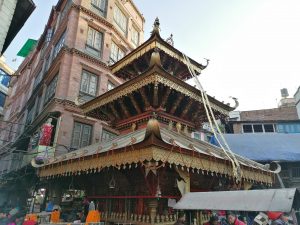
3. Asan Tole
Asan Tole is a famous market street in the city of Asan, Kathmandu. The six spoked junctures of the street is always bustling with people selling everything from vegetables and fishes to clothes, jewellery and spices. It is a place where one can experience the daily life of Nepali people.
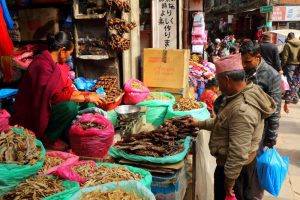
4. Basantapur Tower
Basantapur Tower was the tallest tower in Kathmandu Durbar Square once. Basantapur Tower is an 18th-century monument built during the reign of King Prithvi Narayan of the Shah Dynasty. It has nine storeys, the top two floors of which were destroyed in the 2015 earthquake that hit Nepal. The levels have been restored, and tourists can explore the tower from the outside and the inside. Most of it is hidden behind scaffoldings, and one needs to take a closer look to see the ancient carvings on the restored wooden structure. The entrance is through Lohan Chowk up a narrow staircase, and one can enjoy a fabulous view of Kathmandu through the windows on every floor.
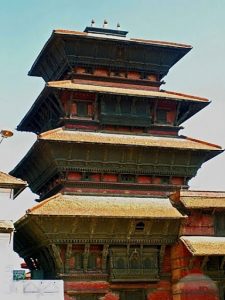
5. Boudhanath Stupa
Boudhanath is a stupa in Kathmandu, Nepal. Located about 11 km from the center and northeastern outskirts of Kathmandu, the stupa’s massive mandala makes it one of the largest spherical stupas in Nepal. The Boudha Stupa dominates the skyline; it is one of the largest stupas in the world.
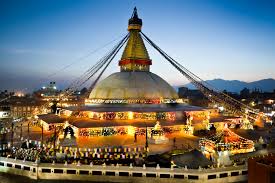
6. Budhanilkantha Temple
Budhanilkantha Temple, located in Budhanilkantha, Nepal, is a Hindu open-air temple dedicated to Lord Vishnu. Budhanilkantha Temple is situated below the Shivapuri Hill at the northern end of the Kathmandu valley. and can be identified by a large reclining statue of Lord Vishnu.
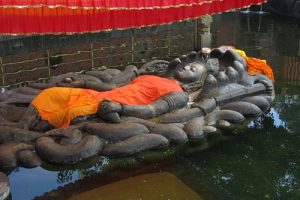
7. Chandragiri Hills
Chandragiri Hill is seven kilometres from Thankot, and lies on the south-west side of Kathmandu Valley which is 2551 metres above sea level. The hill provides panoramic views of Kathmandu Valley and the Himalayan ranges from Annapurna to Everest.
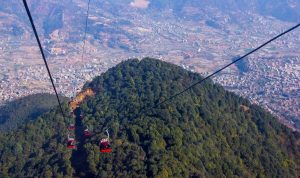
8. Dakshinkali Temple
Dakshinkali Temple, also Dakshin Kali Temple, located 22 kilometres outside Kathmandu and about 1 kilometre outside the village of Pharping, is one of the major Hindu temples in Nepal dedicated to the goddess Kali.
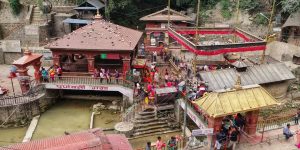
9. Garden of Dreams Kathmandu
The Garden of Dreams, also, the Garden of Six Seasons, is a neo-classical garden in Kaiser Mahal Kathmandu, Nepal, built in 1920. Designed by Kishore Narshingh, it consists of 6,895 square metres of gardens with three pavilions, an amphitheater, ponds, pergolas, and urns.
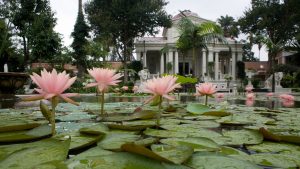
10. Hanuman Dhoka
Hanuman Dhoka is a complex of structures with the Royal Palace of the Malla kings and also of the Shah dynasty in the Durbar Square of central Kathmandu, Nepal. It is spread over five acres. The Hanuman Dhoka Palace gets its name from the stone image of Hanuman, the Hindu deity, that sits near the main entryway.
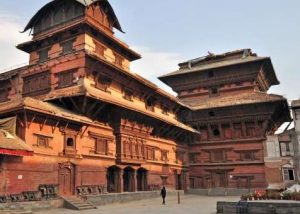
11. Indra Chowk
Packed with colorful shops and stalls, Indra Chowk is a centuries-old market area. There’s a wide range of places for produce, aromatic spices, and textiles, plus a specialist market selling beads, bangles, and ornaments for traditional Nepali weddings. Temples include Seto Machhendranath, with its intricate wood carvings, and Aakash Bhairav guarded by lion statues. Street food stands serve up fried momo dumplings.
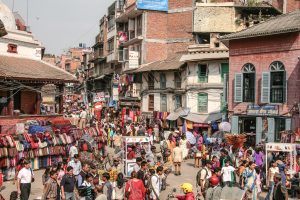
12. Jagannath Temple Kathmandu
The reason why the temple is so famous among the tourists is the various types of erotic carvings on its roof. The temple is located at the Durbar square and it is the oldest structure in this part of the famous Durbar Square. While in his reign, Pratap Malla claimed that it was he who constrcuted the temple and brought it to people’s attention. But when we consider the historical context of the temple, it is said to be made during the 16th century while Mahendra Malla was in the reign. There are two storeys and three tiers in the temple. Although there are three doors, one in each side of the temple only the center door is opened for people to visit it.
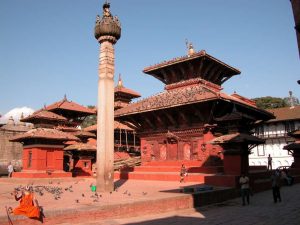
13. Kal Bhairav Kathmandu
Kaal Bhairav, the fifth embodiment of Lord Shiva is one of the less talked about monuments in Kathmandu Durbar Square. Located in the premises of the Hanuman Dokha, it is known to be the fiercest manifestation of Shiva. The meaning of Kaal is “time” or “demise” hence why, he is often considered the “Lord of death or time”. Kaal Bhairav who originated from Hindu mythology is not only an important deity in Newari culture but, also in Buddhism and Jains alike. Onlookers can see the everyday spectacle of worshippers joining their hands together, bowing down and paying their respect.
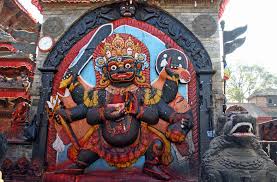
14. Kaiser Library
The Kaiser Library is a government-run public library in Kathmandu, Nepal. It is located in the Keshar Mahal palace complex. The library was established by Chandra Shumsher Jang Bahadur Rana for his son, Kaiser Shumsher Rana, in 1907. The library hosts some rare and ancient books on Buddhism, Tantrism and astrology.
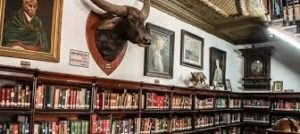
15. Kathmandu Durbar Square
Kathmandu Durbar Suare, A UNESCO World Heritage Site, is one of three squares within Kathmandu Valley in Nepal. Durbar Square (durbar translates to “palace” or “a court held by a prince”) is an important site for Buddhist and Hindu rituals, holy ceremonies, royal events, and kingly coronations.
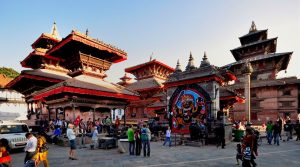
16. Kathesimbhu Stupa
Located in the heart of Kathmandu, the Kathesimbhu Stupa is famous for being the copy of the Swayanbhunath Temple. The courtyard, also called the Swayambhunath Complex, is quite a surprise when tourists find it while exploring the region. It comprises of a stunningly grand 16th-century stupa installed in between smaller stupas. The entrance is marked by a concrete gate, and there are no compound walls to the attraction.
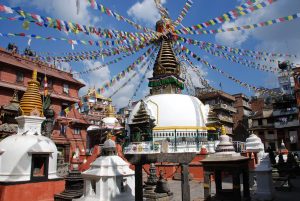
17. Kopan Monastery
Kopan Monastery is a Tibetan Buddhist monastery near Boudhanath, on the outskirts of Kathmandu, Nepal. It is a member of the Foundation for the Preservation of the Mahayana Tradition, an international network of Gelugpa dharma centers, and once served as its headquarters.
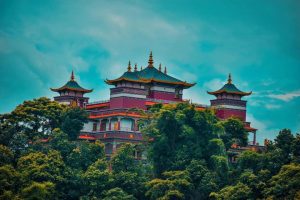
18. Kumari Bahal
The Kumari Bahal in Kathmandu is located at the intersection of Durbar and Basantapur Squares. The structure is basically a three storey building constructed from red colour bricks. This building is the living home of the living goddess of the town people. This religious site in Kathmandu draw attention from tourists and locals owing to the belief related to the living goddess. A girl is selected to be the living goddess of the town till the time she reaches puberty, after which she converts back to living like a mortal. At this attraction in Kathmandu, this girl is treated as the god, the devi, and revered such as one as well according to the Hindu beliefs and mythology.
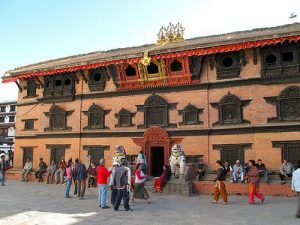
19. Langtang National Park
Langtang’s expansive high meadows provide summer habitat for numerous ungulate species such as musk deer and Himalayan tahr. The park is also well known for its populations of red panda, Himalayan black bear, snow leopard, wild dog, ghoral, serow and more than 250 species of birds.
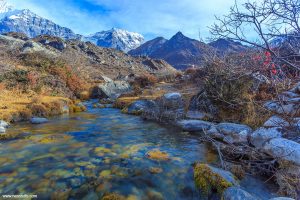
20. National Museum of Nepal
Nepal is the name given to the region of magnificent mountain ranges of the Himalayas and thin stretch of plain lands on its south between the east meridians and the south parallels. The country with elongated rectangle shape lying along the slopes of the mighty Himalayas nearly all along its northern frontiers. Nepal has over 240 peaks above 20,000 ft. above sea level and the queen of these is Sagarmatha (Mount Everest), the highest mountain in the world. The territory of Nepal from east to west is about five hundred miles long and the breadth is between one hundred to one hundred and forty miles. Nepal is well- known all over the world as a land of Gautam Buddha, the light of Asia, who was born in Lumbini grove in sixth century B.C.
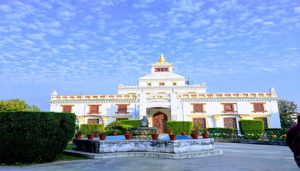
21. Narayanhiti Palace
The Narayanhiti Palace Museum is a public museum in Kathmandu, Nepal located east of the Kaiser Mahal and next to Thamel. The museum was created in 2008 from the complex of the former Narayanhiti Palace following the 2006 revolution.
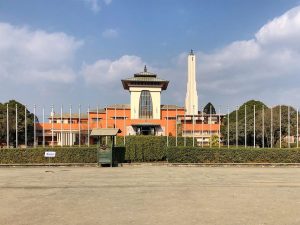
22. Pashupatinath Temple
The Pashupatinath Temple is a famous and sacred Hindu temple complex that is located on the banks of the Bagmati River, approximately 5 km north-east of Kathmandu in the eastern part of Kathmandu Valley, the capital of Nepal. The temple serves as the seat of Pashupatinath.
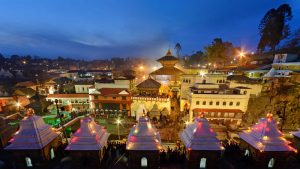
23. Phulchowki
Phulchowki which means ‘Hill of Flowers’ in Nepali is the highest hill (2782m) among the surrounding hills of Kathmandu valley which is located approx. 14 km in the south east of Kathmandu valley. It is the name of one of the famous Hindu goddesses and many Hindu people make their pilgrimage tours to this site.
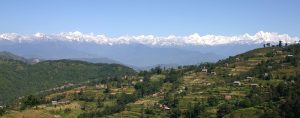
24. Royal Botanical Gardens Kathmandu
The Royal Botanical Gardens, found 18 kilometres south of Kathmandu in the foothills of Mount Phulchowki (2715 m) and surrounded by an evergreen forest, are a site of outstanding beauty. Opened by King Mahendra Bir Bikram Shah Dev in 1962, the Botanical Gardens—the only in Nepal—now hold over 500 species of plant in 82 hectares. Highlights include the decorative Coronation Pond, visitor centre (with interesting exhibits on Nepal’s flora), greenhouses, and collections of rhododendrons (Nepal’s national flower), lilies, orchids, cacti and ferns. Spring and autumn are the peak flowering seasons and therefore the best times to visit.The Godavari Spring, found 200 metres from the Botanical Gardens’ main gate, is also well worth a look. This freshwater spring spouting ice-cold water from the Gadavari river is reputed to have been created when the Buddhist Mystic Padmasambhava struck a rock (in order to demonstrate that the ultimate truth is clear and will fulfill the people’s thirst); unsurprisingly, the Spring is a popular Hindu and Buddhist pilgrimage site. Those with more energy will enjoy a hike to the top of Phulchowki, the highest hill in the Kathmandu valley, to take in the views and a small Buddhist shrine at the summit.
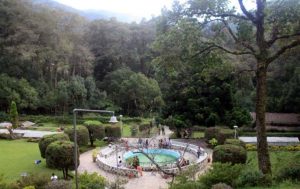
25. Seto Machindranath Temple
The temple of Seto Machindranath is located in Jana Bahal (also known as Machhindra Bahal). Located between Asan and Indra Chok in central Kathmandu, the temple is believed to have been established around the 10th century. Seto Machindranath is worshipped as an aspect of Avalokiteshvara.
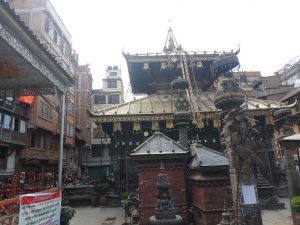
26. Siddhartha Art Gallery
Sangeeta Thapa and internationally recognized artist, Shashikala Tiwari, established Siddhartha Art Gallery on September the 27th, 1987 as a contemporary art space and meeting point for artists from Nepal and abroad. In 1997, the Gallery relocated to the magnificent Baber Mahal Revisited complex. The Siddhartha Art Gallery has been active in the promotion of contemporary Nepalese art and has strived to introduce international perspectives in art, to the Kathmandu community. Over the year’s artists from India, Pakistan, The Netherlands, Bangladesh, Sri Lanka, Syria, Palestine, Afghanistan, South Africa, Mauritius, Taiwan, China, Jordan, Canada, France, Austria, Australia, Finland, Aruba, Curacao, Cuba, Iran, Italy, Malaysia, Japan, China along with the Autonomous Region of Tibet, Korea, Belgium, Germany, the United Kingdom, and the United States have held their exhibitions at the Gallery.
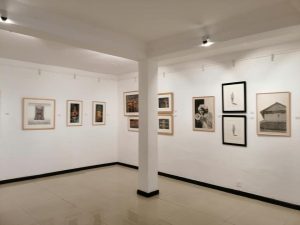
27. Swayambhunath Stupa
Swayambhu is an ancient religious architecture atop a hill in the Kathmandu Valley, west of Kathmandu city. The Tibetan name for the site means ‘Sublime Trees’, for the many varieties of trees found on the hill.
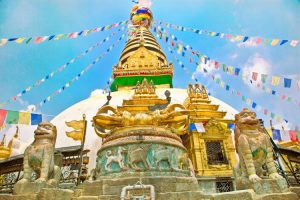
28. Talaju Temple
The Talaizhu Temple, built in 1549, is a three-storey Jinbaoding temple, more than 40 meters high. It is the tallest temple building in Kathmandu with a typical Nepalese architectural style.
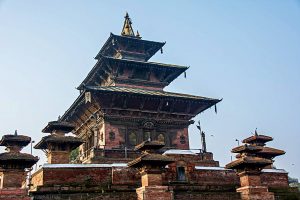
29. Taudha Lake
Taudaha Lake is a small lake in the outskirts of Kathmandu, in Nepal. The name comes from a combination of Newari words ‘Ta’, meaning snake and ‘Daha’, which means lake.
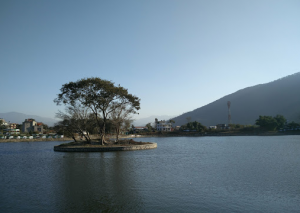
30. Thamel Bazar
A buzzing, visitor-friendly area, Thamel is the city’s main nightlife zone. Bars blast out live music by cover bands, and lively eateries serve Nepalese and international dishes. Designed in 1920, the stately Garden of Dreams is dotted with pavilions, fountains, and urns. Markets and stores sell metal handicrafts, colorful jewelry, and trekking gear, while pedestrianized Mandala Street has upmarket shops and spas.
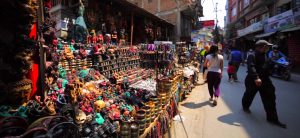
31. The Crematoria (Pashupati Ghat)
Located near the Pashupatinath Temple on the banks of Bagmati River, the crematoria is the place in Kathmandu where Nepali Hindus go to have their last rites. People of different beliefs perform varied kind of funeral practises here. Visitors can sit on the other bank of the river and observe the last rites.
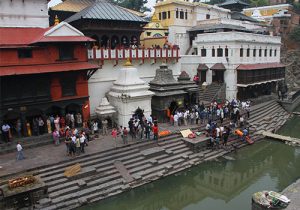
32. Tribhuvan Museum
It is located in the Hanuman Dhoka Palace. This palace was the main seat of the Shah kings for many years. Here is an exhibit that highlights the life of King Tribhuvan. King Tribhuvan is best remembered for his valiant efforts in liberating the nation from the rule of the Rana prime min isters. You may also wish to look out over Kathmandu from the Basantapur Tower in the complex. It is said that a benevolent king used to keep watch over his people from this window to make sure that food was being cooked in every home (the smoke coming from the roof-tops told him whether or not a cooking fire was on in every house). You may also wish to see the section that carries the mementos of King Mahendra and observe the Malla architecture and carvings.
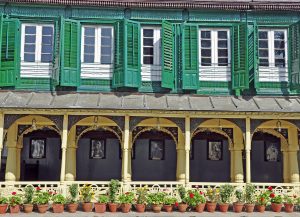
33. Vajrayogini Temple
Bajrayogini Temple is a Tantrik temple located at Sankhu in Nepal’s Kathmandu Valley. It is also well known as Bodhisattva’s Temple. The temple is actually a sort of temple complex, with the main temple having been built by King Pratap Malla in the sixteenth century.
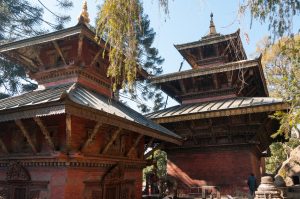
34. White Monastery
White Monastery or Seto Gomba, also known as Amitabha Monastery, is a Buddhist Monastery in Nepal, offering a mix of religious importance and natural anesthetic. The vivid terrain and the lush green landscape of the surrounding make the sunset and sunrise here, a treat to watch. Visitors can observe the whole of the Kathmandu Valley from this place. The soothing atmosphere draws most travellers wanting to soak up some tranquillity after exploring the bustling city of Kathmandu.
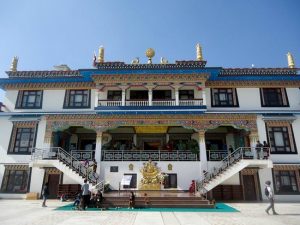
1. Marvel Over Historic Durbar Square
2. Walk Through the Old City
3. Shop and Hang Out in Thamel
4. Explore the Backstreets of Kathmandu
5. Try the Local Cuisine
6. Dodge Monkeys at Swayambhunath
7. Get a Blessing at Pashupatinath
8. Circumambulate Boudhanath
9. Visit Villages in Kathmandu Valley
10. Hike Shivapuri National Park
11. Mount Everest Sightseeing Flight
12. Try Tasty momos
13. Hiking Around Kathmandu
14. Visits Casinos
15. Take a Class or Workshop (Yoga, Ayurveda, Thanka, Cooking etc.)
Generally, Kathmandu is safe to visit, and it’s known for extremely friendly people and hospitality towards tourists and visitors. It is no stranger to tourists, is extremely friendly to visitors, and is very well organized for traveling around. Its crime rates are low, though you should still exercise caution.

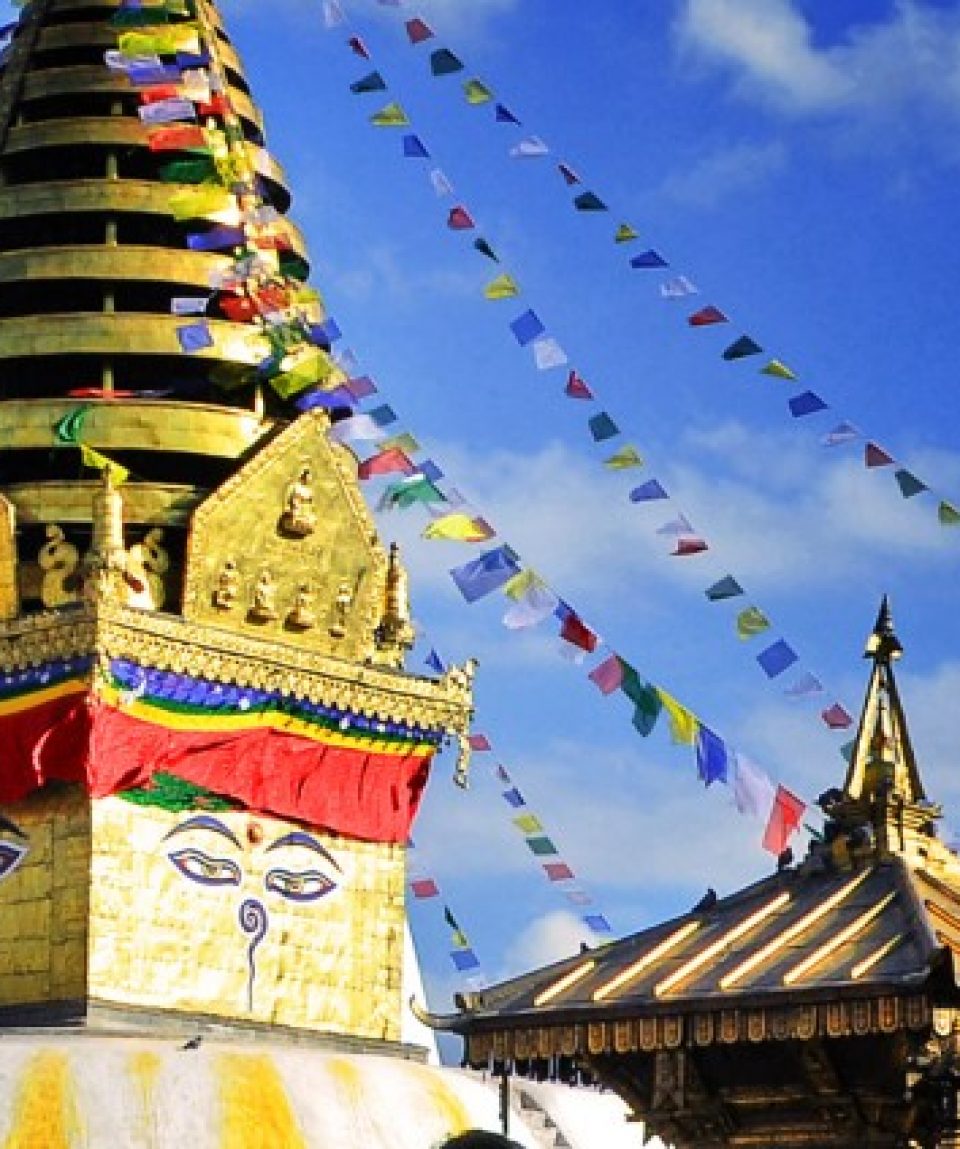
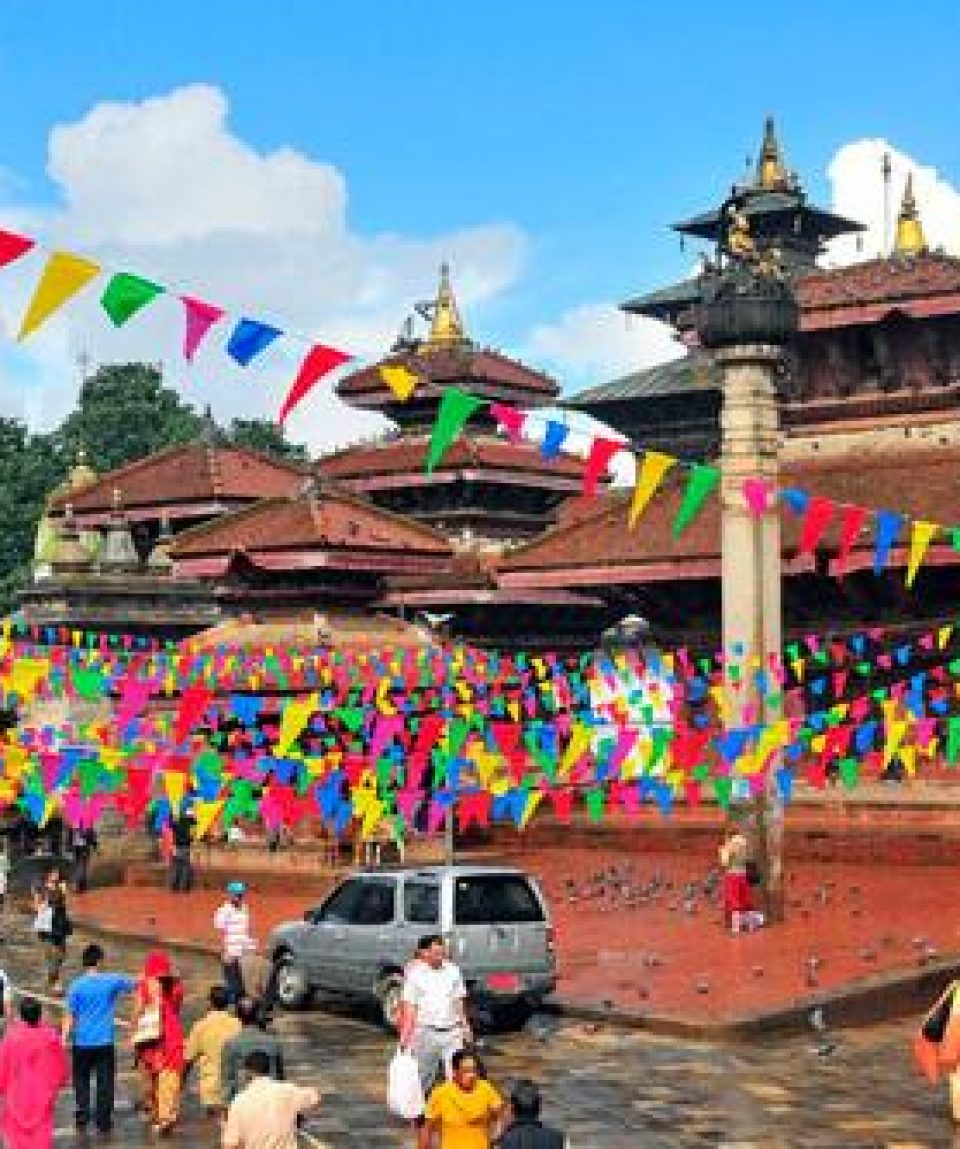
I was amazing experience living in Kathmandu with such great people
I was amazing experience living in Kathmandu with such great people
To spend some days in Kathmandu is a very strong experience.